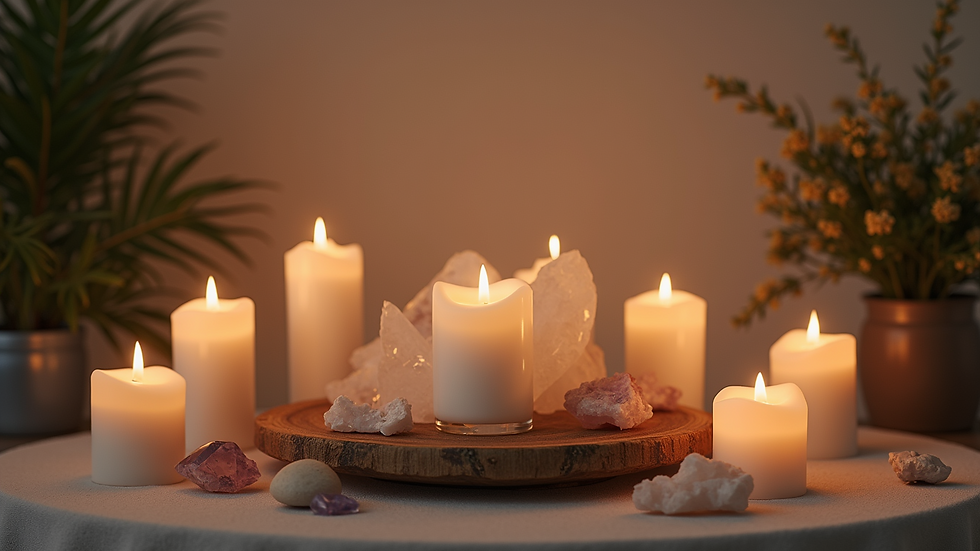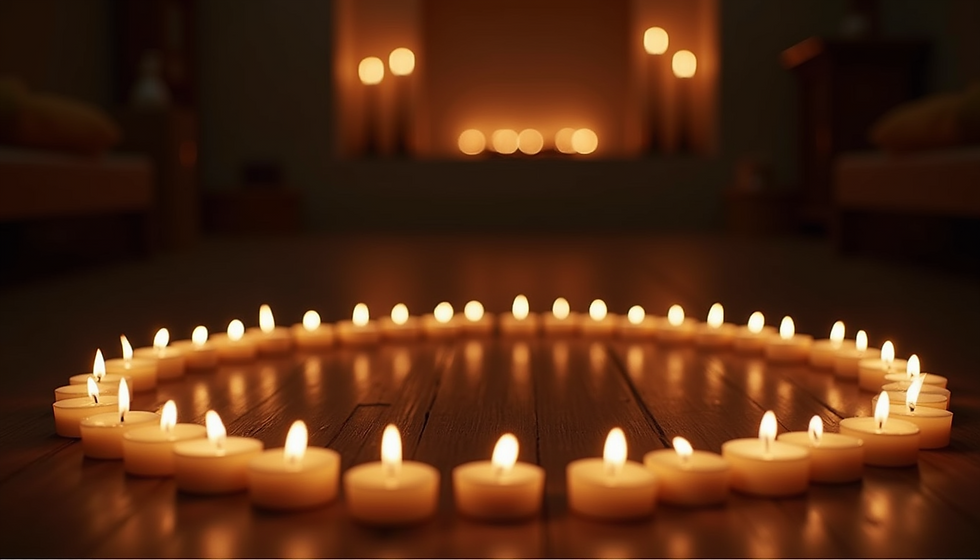Embracing Wiccan Rituals: A Journey of Connection and Intention
- Gaia Naos
- Sep 24
- 4 min read
Updated: Oct 10
Understanding the Purpose of Rituals
Wiccan rituals are powerful tools for connecting with the divine, honoring nature's cycles, and manifesting your intentions. Whether you're celebrating the Sabbats, marking personal milestones, or seeking guidance, every ritual serves a distinct purpose. For instance, rituals performed during the winter solstice (Yule) emphasize rebirth and new beginnings, while those at Samhain focus on honoring ancestors and reflecting on the past. A clear understanding of a ritual’s purpose shapes the entire experience, making it more meaningful.
Creating Sacred Space
Creating a sacred space is foundational to any Wiccan ritual. This process helps clear negative energy and sets a welcoming environment. Common cleansing methods include burning sage, sprinkling salt, or using water with specific intentions. After cleansing, practitioners typically cast a circle. This circle acts as a protective boundary, shielding the ritual from external disruptions. In a study of Wiccan practitioners, over 70% reported feeling more focused and spiritually connected when they created a designated sacred space prior to rituals.
Tools of the Trade
Wiccans often incorporate specific tools during their rituals. Each tool has its own significance. Here are some common ones:
Athame: A ceremonial dagger that channels energy. It symbolizes the element of Fire and the power of will.
Wand: Usually made from wood or crystals, a wand directs energy and intention. For example, a rosewood wand is linked to love and healing.
Chalice: This cup holds offerings or beverages. It can symbolize the element of Water and the divine feminine.
Pentacle: A disk featuring a pentagram, representing Earth and the interconnectedness of all elements.
While these tools can enhance your ritual, the intention behind their use is what truly matters. Many practitioners find that using tools helps them focus their energy and intention more effectively.
Invoking the Elements
Wiccan rituals often involve invoking the four elements: Earth, Air, Fire, and Water. Each element carries unique meanings:
Earth: Stability and nurturing, often represented by crystals or plants.
Air: Communication and intellect, symbolized by incense or feathers.
Fire: Transformation and passion, often represented by candles or a flame.
Water: Emotions and intuition, typically symbolized by a bowl of water.
Invoking these elements promotes a balanced atmosphere. According to a survey, 85% of Wiccans feel a stronger connection with nature when they consciously invoke these elements during rituals.
Calling the Quarters
Many Wiccans call upon the four cardinal directions, known as the "quarters." Each quarter corresponds to an element and embodies particular energies:
East: Linked to Air and new beginnings.
South: Represents Fire and transformation.
West: Associated with Water and emotions.
North: Connected to Earth and stability.
Calling the quarters invites these elemental energies into the ritual space, enriching the experience. This practice not only connects practitioners with the natural world but also invokes a sense of unity within the ritual.
The Ritual Itself
The heart of any Wiccan ritual lies in its ceremony, which can vary in structure depending on its purpose. Common elements include:
Invocations: Summoning deities or spirits for guidance. For instance, invoking the goddess Brigid can inspire creativity and healing.
Meditation or Visualization: Focusing your thoughts to reach a deeper connection with the divine or manifest your goals.
Offerings: Presenting gifts to nature or deities, which could include herbs, flowers, or personal items.
Chants or Prayers: Reciting empowering words to raise energy. For instance, saying "Blessed be" reinforces intentions of goodwill and positivity.
The beauty of Wicca is its flexibility; practitioners can adjust rituals to suit their beliefs and preferences.
Closing the Ritual
Properly closing the ritual is just as important as the ceremony itself. Acknowledging the deities and elements for their presence is essential. Many practitioners also release the circle, marking the end of the sacred space. This step not only grounds the energy raised during the ritual but also provides closure to the experience. A smooth transition back to everyday life after a ritual leads to better integration of its lessons.
Reflection and Integration
After completing your ritual, taking time for reflection is essential. Consider journaling about your feelings, insights, and any messages you may have received. This practice can significantly deepen your understanding of your spiritual journey. Reflecting on rituals helps practitioners integrate insights into daily life, fostering continued growth.
In a recent study, 90% of Wiccans who engaged in post-ritual reflection felt they gained deeper insights into their spiritual path.
Embracing the Journey
Wiccan rituals offer a profound way to connect with the divine, nature, and yourself. Understanding these essential elements equips you to create meaningful experiences that resonate with your spiritual journey. Whether you are a long-time practitioner or just starting, incorporating these components enhances your rituals and deepens your connection to the world around you. Remember, the essence of any ritual lies in the intention behind it, so let your heart guide you as you explore this enchanting path.
To Learn More
Join us for a Mabon / Autumn Equinox Ritual at Mythic Treasures, 1225 Jefferson Rd. Rochester on September 25, 2025 at 6:00 PM. We will be explaining and demonstrating these elements and more. The ritual is free and open to all who wish to join. Blessed Be!






Comments